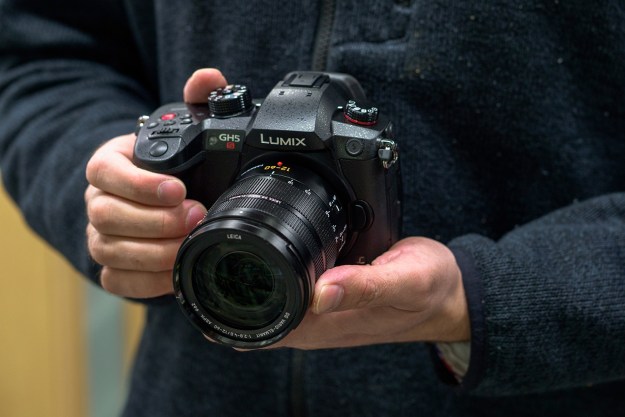
- 10MP multi-aspect-ratio sensor
- Best video quality in this class
- DCI 4K at 60 fps
- 1080p at 240 fps
- Waveform, vectorscope, and time code sync
- No image stabilization
- Chintzy rear control dial
The Panasonic Lumix GH5S was one of the few gems to come out of the Consumer Electronics Show this year (it won our Top Tech of CES 2018 award). The Micro Four Thirds mirrorless camera is largely identical to the standard GH5, which received a Digital Trends Editor’s Choice award in our review thanks in part to its many innovations in video. Panasonic has now doubled down on that approach. The S model incorporates several key hardware and software changes that give it an even tighter focus on professional video creators, all while helping the relatively small Micro Four Thirds sensor punch well above its weight.
We don’t use the term “professional” here lightly. The $2,500 GH5S not only costs more than the standard model, but also won’t appeal to as broad a demographic. Its video quality pushes into cinema camera territory, but still photographers have little reason to consider it. There is also one key feature — in-body image stabilization — that is missing, meaning many video shooters may prefer the standard GH5, as well.
All of this is to say that the GH5S cannot really be compared side-by-side with other mirrorless cameras, but for a certain sect of Panasonic fans, this is the GH camera they’ve always wanted. We have to admit, it is refreshing to see a major corporation produce such a niche product for a small but dedicated group of users, even if it’s not the all-out better camera.
Note that the GH5S does not replace the GH5, but exists as a companion camera.
Designed to be practical, not pretty
The GH5S is almost identical to the GH5 on the outside, save for a bright red “REC” button on top and other very minor details. Due to the removal of the 5-axis stabilization system, the camera is a bit lighter, as well. It’s not a huge difference — maybe the equivalent of removing the battery — but it is noticeable.
Other than that, it’s business as usual. It has the same 3.68-million-dot electronic viewfinder, 1.62-million-dot articulating LCD touchscreen, and ruggedized build. It’s not the prettiest mirrorless camera we’ve seen, and it doesn’t feel quite as refined as the stills-oriented Lumix G9, but it is still certainly functional.
If we can nitpick, we are a bit unimpressed with the feel of some of the controls. The lower rear command dial and associated four-way buttons feel particularly flimsy and cheap for a $2,500 camera, and the autofocus point selector joystick isn’t as “clicky” as we would like. Also, plugging in headphones (or HDMI or USB cables) still interferes with the articulating screen.
Just the pixels you need
The first spec that jumps out about the GH5S is its 10.2-megapixel sensor, which is roughly half the number pixels of the standard GH5. This decision may seem a bit odd, as if Panasonic is asking customers to pay more for less, but it’s actually a good thing for video.
The GH5S sports a 10.2-megapixel sensor, which may seem odd, but is actually is a good thing for videographers. With fewer pixels on the sensor, each pixel can be larger, increasing its sensitivity to light which should boost low-light performance.
While a few full-frame and medium-format cameras continue to duke it out in the fabled megapixel war, consumers have finally wised up to the fact that more doesn’t always equal better (and manufacturers, in turn, have wised up to consumers wising up). By putting fewer pixels on the sensor, each pixel can be larger, increasing its sensitivity to light which should boost low-light performance. In fact, the GH5S has a new maximum ISO of 51,200, two stops greater than the GH5.
This doesn’t matter quite as much to still photographers, who could downscale their 20MP GH5 photos to 10MP to cut out high ISO noise, but videographers don’t have that same flexibility. This is why starting out with fewer, larger pixels (so long as you still have enough for 4K resolution) is so exciting to video shooters. But low-light performance isn’t the only benefit of the camera’s lower resolution when it comes to video.

Arguably, 4K video has more than enough resolution for all but the most demanding applications (for example, if you need to have the freedom to significantly crop and reframe your footage). Yet, it only measures 3,840 x 2,160 pixels — or about 8.3 megapixels, a number that hasn’t been impressive on a digital still camera since 2006. Shooting video from a higher resolution sensor poses a problem: What do you do with all those extra pixels?
One method is simply to ignore them, using pixel skipping or binning to cut out the pixels you don’t need. The superior method is to oversample the pixels, pulling higher resolution than you need from the sensor and letting the processor downscale it to 4K. In fact, many mirrorless cameras today — including the GH5 — oversample 4K video from roughly a 5K region of the sensor.
The sensor in the GH5S, however, is specifically designed to produce DCI 4K (that’s 4,096 x 2,160 pixels) with exactly the number of pixels it needs; no more, no less. One pixel is recorded for every pixel that is processed and output in the final frame.
The sensor in the GH5S is specifically designed to produce DCI 4K (that’s 4,096 x 2,160 pixels) with exactly the number of pixels it needs; no more,
no less.
While this 1:1 sampling is certainly better than pixel skipping or binning, oversampling should technically still produce sharper results (for a headache-inducing explanation of why this is, read up on the sampling theorem). However, due to current limitations of sensor and processor technology — at least anywhere near this price point — a camera like the GH5 has to read out pixels one line at a time, often called an electronic rolling shutter. The more pixels it records, the longer this process takes, which makes the dreaded jello cam effect worse. This is particularly troublesome for handheld shots, quick pans, or when shooting fast-moving subjects, which will look like they are “leaning” in one direction.
The GH5S, then, should produce less jello cam, have greater low light performance, and still maintain sharp video with 1:1 sampling all thanks to its lower-resolution sensor. But that’s not all: The new sensor also uses an oversized, multi-aspect ratio design, maximizing field of view whether you select 4:3, 3:2, 16:9 (Ultra HD), or 17:9 (DCI 4K). This is somewhat of a return to form for Panasonic, which used multi-aspect ratio sensors in GH-series cameras up until the GH3.
New tools for video pros
The sensor isn’t the only video-specific upgrade in the GH5S. The camera is packed with features that make it more familiar, more useful, and more versatile as a video camera than the GH5 before it (which, admittedly, was already pretty great in this regard).
First up, V-Log L — a $100 add-on for the GH5 — is now included standard, as is Hybrid Log Gamma (HLG). V-Log L is Panasonic’s implementation of a logarithmic tone curve, which preserves more dynamic range, but the picture comes out looking “flat” and must be color graded. Fortunately, the GH5S now has a LUT display function, which lets users preview, in camera, log footage in a closer to final state — something that could only be done on the GH5 through an external monitor.
Old school filmmakers will also appreciate the option to display shutter angle in place of shutter speed
That’s not the only cue the GH5S took from external monitors. The camera now has video scopes built-in, including waveforms for judging exposure and a vectorscope for color. Having these tools right in the camera means users can produce more accurate footage when an external monitor can’t be used, such as in run-and-gun situations or when mounting the camera as a crash cam or in another tight spot.
Old school filmmakers will also appreciate the option to display shutter angle in place of shutter speed, while the ENG crowd will like that ISO can be displayed in terms of decibels of gain. If these additional terms don’t mean anything to you, don’t worry — just stick to shutter speed and ISO and everything will function like you expect it to.
Finally, the GH5S has time code in/out via its flash sync port (a BNC adapter cable is included with the camera) so it can sync to other professional video cameras. This is huge for multi-camera productions where keeping different angles in sync is critical, like recording live events or shooting music videos, or even just a two-camera interview.
Video that looks like film
All of the tech, all of the high-end features, would be for naught if Panasonic didn’t deliver on its promise of excellent video quality. Fortunately, it absolutely did. This camera produces the best video quality of any camera we have had the privilege of reviewing, with film-like contrast and color that really pushes beyond our expectations for a Micro Four Thirds sensor. This sensor has just about a quarter of the surface area of a full-frame sensor, and yet we had no trouble capturing beautiful video under different lighting conditions.
Panasonic’s impressive processing takes most of the credit for this. We shot primarily in the highest-quality, 4:2:2 10-bit codec at 400 megabits per second and in V-Log L. The footage grades incredibly well, and it’s always impressive to see how much color can be pulled out of such a flat looking file. We also appreciate the convenience of being able to record such high-quality video directly to SD card.
However, such a strong codec calls for equally strong computing power to process and edit the footage (we ended up transcoding to Apple ProRes 422 just to get it to play back smoothly on this writer’s nearly six-year-old iMac). You’ll also need a large, fast memory card. Ten minutes of video at 400Mbps requires nearly 32GB of storage. Panasonic recommends at least a V60-rated UHS-II SDXC card.
You’ll also need a large, fast memory cards to shoot at the highest settings in the GH5S. Ten minutes of video at 400Mbps requires nearly 32GB of storage.
We tested V60 cards from ProGrade Digital and did not encounter any issues, but the company’s new V90 cards are made expressly with the GH5S in mind. Alternately, you can record video from the clean HDMI output into an external recorder, but make sure to look for one that supports the GH5S’s high frame-rate options, like the new Atomos Ninja V. To be clear, the GH5 offers this same high-bitrate codec, but the GH5S takes advantage of some new hardware tricks that make its video look even better. One we’ve already talked about — the 10.2MP sensor — and the other is what happens directly behind that sensor.
Borrowing a technology from its professional Varicam line, Panasonic has introduced dual native ISO into a Lumix camera for the first time in the GH5S. As a Panasonic representative explained it, this puts two capacitors behind each pixel, each tuned for a different ISO range. This gives the GH5S two different ISO settings that are both “zero gain,” providing better dynamic range at low ISO while reducing noise at high ISO. (Panasonic states the GH5S can hit 14 stops of dynamic range for RAW still photos, but hasn’t actually listed dynamic range for video, which is likely a tad lower due to the lack of a RAW video format.)
The practical effect of dual native ISO is that videographers have greater flexibility for working in different lighting conditions, as they won’t have to rely as much on artificial lights or neutral density filters in order to control the light to be able to use the best ISO setting. The camera can also smoothly ramp ISO automatically for natural transitions from indoors to out.

Particularly when shooting in V-Log L, noise is still apparent throughout the ISO range, but it is well controlled and not altogether unattractive up to ISO 6,400. You can minimize noise by overexposing the shot when possible, taking advantage of the extra dynamic range in V-Log L.
We also shot some test footage at ISO 25,600 under very dim lighting, and it definitely started to fall apart when we tried to grade it. However, it was still possible to get to a point which we considered “usable,” but the demands of your particular project will dictate how that is defined. For example, documentary and news shooters may be okay with a noisy image, while narrative filmmakers might not.
The GH5S also offers some new high frame-rates over the GH5. While the GH5 introduced Ultra HD 4K (3,840 x 2,160) at 60 frames per second, the GH5S brings that frame-rate to DCI 4K (4,096 x 2,160) — a world’s first. That means users of the wider format can now shoot slow-motion footage without dropping resolution. And at 1080p, the GH5S can shoot as fast as 240 fps, up from 180 in the GH5, albeit with a small crop.
From a usability standpoint, we found face-detection autofocus to work very reliably. Many users had reported this being an issue with the GH5, and while we haven’t done a direct comparison, it would seem the GH5S does not suffer from the same focusing inconsistencies.
Why some videographers won’t want the GH5S
In the professional filmmaking world, the GH5S probably makes sense for most users, but there is one potential area where even high-end shooters will find it outclassed by the GH5: anamorphic 4:3 shooting. The GH5S still has this ability, but due to the lower pixel count, it is limited to 4K resolution. The GH5 can record 6K anamorphic footage, which is quite impressive, especially for a $2,000 mirrorless camera. Still, when you throw in the better noise performance and lower risk of jello cam, the GH5S may be the better choice.
The main drawback of the GH5S is the lack of in-body image stabilization.
For everyone else, the main drawback of the GH5S is the lack of in-body image stabilization. The standard GH5 has a fantastic 5-axis sensor-shift stabilization system, which makes it easier to use handheld. This doesn’t matter as much to studios and larger productions, where the camera is likely to be stabilized in robust rigs and gimbals, but it could be more important to single operators than all of the video benefits of the GH5S combined.
Time-lapse photography is also better left to higher-resolution sensors. The GH5S has internal intervalometer and time-lapse controls, but it won’t offer the same flexibility for zooming and panning in post as the 20MP GH5.
Still photography is not in the cards
If you’re a still photographer, Panasonic doesn’t mind if you say no the GH5S — the company will very happily sell you the new Lumix G9. The GH5S does have one potential advantage over the both the GH5 and the G9, however: 14-bit RAW files. This is to hold the extra data from the increased dynamic range of the 10.2MP sensor.
However, in our experience, this did not seem to make a noticeable difference. This isn’t surprising — even with full-frame cameras, the advantages of 14-bit files can be difficult to spot. That said, the files out of the GH5S do look very good, so we certainly wouldn’t hesitate to use it as a still camera — just know its limitations. It also produces less noise, but that benefit is erased when the larger GH5/G9 file is downscaled to 10MP (which produces an overall sharper image, as well).
On the topic of noise, the lack of in-body image stabilization also means you may have to resort to higher ISO settings on the GH5S than you would on the GH5/G9 in order to keep your shutter speed fast enough to prevent blur. This, too, could erase the sensor’s low-noise advantage.
Other than the resolution and stabilization, the GH5S retains most of the great still camera features of the GH5. The viewfinder can refresh at up to 120 fps, and Panasonic’s excellent Depth from Defocus autofocus system returns, but is now sensitive down to -5EV. In dark scenes, the AF definitely hunts more and takes longer to lock in, but very rarely did it miss focus in single-shot mode.
Photos from the GH5S do look very good, so we certainly wouldn’t hesitate to use it as a still camera — just know its limitations.
Given the lower resolution, we may have expected a higher continuous shooting speed, but burst rate remains the same at 12 fps with AF locked or 8 with continuous AF (11 or 7, respectively, in 14-bit mode). These are still impressive numbers, however, so we’re not complaining. We also didn’t notice the same speed reduction when shooting at smaller apertures that we encountered on the G9, but this may be at least partly due to the specific lenses we were testing with each camera.
We have to conclude that the GH5S does not fill the role of a still camera, but if video is your primary focus, this probably won’t bother you.
Our Take
Over the past decade or so, we’ve seen some significant evolutions in digital imaging. The gains made in still photography have been impressive, but what’s happened in the video world has been nothing short of monumental. The Lumix GH5S is part of an entirely new paradigm of video cameras compared to the high-end camcorders that used to dominate the market, and it’s worth a brief moment to pause and appreciate what a marvelous time this is for filmmakers. It’s not just that today’s tools are the best they’ve ever been, but that we have access to an entirely new class of tool — especially those of us without a large studio’s budget.
The GH5S is a very exciting camera for a relatively small number of people, and we are rather impressed — perhaps even a bit shocked — that Panasonic made it. It may look like a hybrid mirrorless camera, but it is a professional production camera through and through, one that could see use in everything from student films to Hollywood blockbusters. It is a (relatively) affordable entry point into the world of cinema cameras, and a capable B camera and crash cam for high-budget productions. Oh yeah, and it’s a decently capable still camera if you happen to want to take some photos.
However, the niche appeal of the GH5S means it comes at a $500 premium over the standard model. Understandably, this is still a very cheap camera from the perspective of many professional shooters, but it might keep advanced tools like video scopes and time code sync out of the hands of budget-conscious amateurs and students who could benefit from learning and working with those tools.
Is there a better alternative?
For the GH5S’s specific target demographic, no. This camera produces the most stunning video we’ve seen at this price point, and gives users more options and greater control than competing models. It is one of the best sub-$3,000 video cameras out there — Blackmagic Design’s brand new Pocket Cinema Camera 4K is another contender — and it even gives more expensive models a serious run for their money.
However, the standard GH5 — or any number of other high-end mirrorless cameras from various manufacturers — is a better choice for most customers. By and large, the GH5S was built for the type of filmmaker who already knows they want it. If you don’t fall into that camp, chances are it’s safer to go with the standard GH5.
How long will it last?
The GH5S strikes out in a bit of a new direction for Panasonic, but if it’s anything like other range-topping cameras, we expect it to have a two-to-three-year life cycle. While a few of the controls felt flimsy, the camera is otherwise very well made and should hold up to the rigors of professional use for a long time.
Should you buy it?
Here’s the kicker: If you’re asking yourself this question because you’re trying to decide between this and another mirrorless camera, the answer may very well be no. The GH5S is a narrowly focused product for a small group of users, and its benefits simply won’t be obvious to everyone — nor will they necessarily outweigh its detriments, like the higher cost, lower resolution still photos, and lack of built-in image stabilization.
As a consumer technology site, we have to acknowledge that the GH5S does not bring as much value to as many people as the regular GH5. Vloggers, travel and wedding videographers, and still photographers who need a capable hybrid camera are all likely better off with the non-S model. This is why we’re giving the GH5S a lower score than its sibling.
That said, if you are among the few who have been looking for a hyper-focused mirrorless camera for shooting video; if you’re not deterred by the challenge of working with log gamma and large files; if you’re simply waiting for yet another confirmation that the GH5S is as good as everyone says it is; then yes, by all means, buy one.
Editors' Recommendations
- Smaller and cheaper, the full-frame Lumix S5 is exactly what Panasonic needed
- The Panasonic Lumix S5: Everything we know
- Panasonic takes on Sony in the vlogging camera game with compact Lumix G100
- Leica SL2 vs Panasonic Lumix S1R: Two L-mount leaders with one big difference
- Panasonic Lumix S1H camera will offer limitless 6K recording for $4,000


















